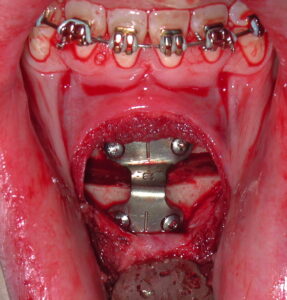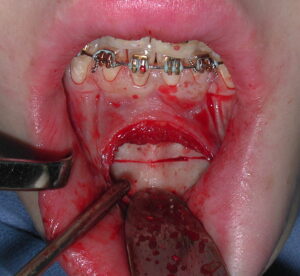The sliding genioplasty is a wonderful operation for the properly selected chin deficient patient. It is a versatile procedure that can be used to achieve a variety of dimensional chin changes. While there are some slight variations in how the procedure is performed, it fundamentally is done by a bone cut below the tooth roots and mental nerve which allows the downfractured chin segment to be repositioned for the desired effect.


The expected aesthetic sequelae is the deepening of the labiomental sulcus even if it is only perceptual. (the sulcus stays in the same position but the chin below it has moved forward) But with soft tissue collapse into the dead space it has the potential to pull inward (scar contracture) making the labiomental sulcus feel tight. This potential effect can be magnified by how the mentalis muscle is reapproximated during closure.
In its most severe form the scar contracture into the dead space not only pulls the labiomental sulcus inward but also drags down the lower lip as well. This can create persistent symptoms of lip and chin tightness and even difficulties with lip competence, smiling and speech. While scar contracture into the created dead space of the chin represents a classic scar contracture problem for those so affected, it has been rarely recognized by those performing the procedure.
The most common intraoperative maneuver to reduce or eliminate the step deformity of the chin from a sliding genioplasty has been to full it in with a variety of materials. Demineralized bone and synthetic hydroxyapatite particles are frequently used and even implants (modified chin implants) have been placed into the step. Surgeons who try to eliminate the step deformity may think of it as a bone restoration effort, which it partially is, but its greatest benefit is in the prevention of scar contracture into the dead space and potentially softening a labiomental sulcus deepening effect.
For those patients so affected with persistent chin and lip tightness after a sliding genioplasty, this biologic understanding of scar contracture into the bony step allows for an effective treatment strategy to be devised. One non-surgical approach is the use of injectable fillers placed underneath the labiomental sulcus. While this is rarely curative most such affected patients will experience some modest improvement in their symptoms. This ‘test’ supports the more definitive treatment which is an intraoral release and fill of the newly created dead space between the bone and the overlying soft tissue with a dermal-fat graft. This approach is like any other scar contracture treated elsewhere in the body…release and interpostional grafting to prevent relapse.
Dr. Barry Eppley
Indianapolis, Indiana



